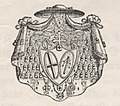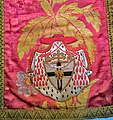Johannes von Geissel
Johannes Baptist Jacob Geissel , from 1839 von Geissel , from 1850 Cardinal von Geissel (born February 5, 1796 in Gimmeldingen , today Neustadt an der Weinstrasse , † September 8, 1864 in Cologne ), was a German cardinal . He served as Bishop of Speyer from 1837 to 1841 and as Archbishop of Cologne from 1845 until his death , where he had already represented his predecessor as coadjutor from 1841 to 1845 .
family


John scourge was the eldest son of from the neighboring Mußbach originating Catholic winemaker and Nicholas scourge of his birth or baptism to the Protestant wife Maria Helena Theresia Motzenbäcker in Gimmeldingen ( Pfalz born), which is a district of Neustadt an der Weinstraße since 1969th The father worked in Mußbach as a manager of the White House estate .
The actual place of birth of the son, the small village of Lobloch , had already been incorporated into the larger Gimmeldingen in 1751. The St. Nikolaus Church in Lobloch has been restored today. A hundred years before the birth of Johannes Geissel, it was robbed of its roof following the War of the Palatinate Succession , and as a result it became a ruin. Therefore, the baptism had to take place in the Catholic parish church of Mußbach.
Life and work
Training and career start
Geissel, whose parents lived in Mußbach, first attended the Latin school in Neustadt, which later became the Kurfürst-Ruprecht-Gymnasium , and then the Latin school in Speyer . From 1815 he studied Catholic theology at the seminary in Mainz , and on August 22, 1818 he was ordained a priest . For a short time he worked as a chaplain in Hambach , from 1819 he taught as a religion teacher in Speyer at the Lyceum, grammar school and Latin school, which preceded the grammar school . On June 24, 1822 he became cathedral chapter in Speyer. There he took over the chairmanship of the cathedral chapter on May 25, 1836 as cathedral dean .
Bishop of Speyer
In 1837 Pope Gregory XVI raised Geissel as bishop of the Diocese of Speyer, the episcopal ordination took place on August 13th in Augsburg by the Archbishop of Bamberg , Joseph Maria von Fraunberg ; Co- consecrators were Johann Peter von Richarz , Bishop of Augsburg , and Barnabas Huber OSB , Abbot of St. Stephan in Augsburg. The enthronement took place on August 30th in the Speyer Cathedral .
Archbishop of Cologne and Cardinal
On September 24, 1841, Pope Geissel appointed Archbishop Clemens August Droste zu Vischering's coadjutor for the Archdiocese of Cologne ; because the archbishop was arrested in 1837 because of differences (" Cologne turmoil ") between the Prussian state and the church in the treatment of interdenominational marriages . After his release in 1839, he lived in exile in Münster, Westphalia . When he died on October 19, 1845, his coadjutor became the new Archbishop of Cologne. On January 11, 1846, he was enthroned in Cologne Cathedral . Pope Pius IX elevated the archbishop to cardinal on September 30, 1850 .
Church politics
Geissel belonged to the Mainz district , a Catholic group that was particularly loyal to the Pope. He was intensively active in the field of church politics and also cultivated the relationship between the church and the secular rulers.
He demonstrated leadership qualities among the German shepherds on several occasions. In 1848, for example, he invited all bishops in the area of the German Confederation to the Würzburg Bishops' Conference . In 1860, after more than 300 years, he again convened a provincial council of the Archdiocese of Cologne.
Geissel was also active in the field of church building. Together with King Friedrich Wilhelm IV. Of Prussia, he laid the foundation stone for the further construction of Cologne Cathedral on September 4, 1842, ending the construction phase that had existed since the first half of the 16th century after around 300 years. In 1863, a year before his death, he was able to inaugurate the nave and transept of the cathedral.
Works
Geissel emerged as the author of books on church history and is one of the most active historians of the re-founded diocese of Speyer (after 1817). Particularly noteworthy is his three-part history of the Speyer Cathedral with many details from the 18th and early 19th centuries, whereby he was largely able to fall back on information from contemporary witnesses who were still personally known to him.
In 1832 Geissel wrote a history of the old Principality of Speyer . His monograph from 1835 on the Battle of Göllheim , which took place in 1298 between Adolf von Nassau and Albrecht of Austria, and the King's Cross , erected in memory, has been reprinted several times until recently.
Around 1835 Geissel composed the hymn of praise, earth, singe, which is still much sung today and which is contained in the hymn book, God's Praise (No. 411) .
Geissel's coat of arms on the Marian column in Cologne
Knee bench with the cardinal's coat of arms, 1858, Johanneskirche Mußbach
Honors
Geissel is considered one of the most important Catholic bishops of the 19th century. King Ludwig I of Bavaria awarded him the Knight's Cross of the Order of Merit of the Bavarian Crown on January 1, 1839 , which was connected with the elevation to the personal nobility . King Friedrich Wilhelm IV honored Geissel in 1855 with the highest award of the Kingdom of Prussia , the Order of the Black Eagle . Since 1857 the cardinal was a foreign member of the Bavarian Academy of Sciences .
When Geissel died in 1864, he was buried in the episcopal tomb of Cologne Cathedral. His place of birth Gimmeldingen honored him with a street dedication (von-Geissel-Straße) ; The house where he was born at Kurpfalzstrasse 182 is marked with a sign. In the Ehrenfeld district of Cologne which is scourge street named after him.
Johannes von Geissel was invested in the order of knights of the Holy Sepulcher in Jerusalem by Giuseppe Valerga , the Patriarch of Jerusalem .
Trivia
When Geissel grew up in Gimmeldingen in the former Electoral Palatinate , French was the official language there, after the German areas on the left bank of the Rhine were occupied by French troops from 1797 during the Napoleonic Wars and formally incorporated into France between 1801 and 1815. Geissel was therefore always influenced by the French language, which he had mainly spoken in school; his German was interspersed with French expressions. This made the mocking Cologne residents to convert the French personal data "Jean Jacques Geissel de Gimmeldingen" into onomatopoeic into "Schang Schack Scheissel de Schimmeldeschang".
literature
- Robert Haaß : Geissel, Johannes von. In: New German Biography (NDB). Volume 6, Duncker & Humblot, Berlin 1964, ISBN 3-428-00187-7 , p. 157 f. ( Digitized version ).
- Leonhard Ennen : Geissel, Johannes von . In: Allgemeine Deutsche Biographie (ADB). Volume 8, Duncker & Humblot, Leipzig 1878, pp. 520-527.
- Friedrich Wilhelm Bautz : Geissel, Johannes von. In: Biographisch-Bibliographisches Kirchenlexikon (BBKL). Volume 2, Bautz, Hamm 1990, ISBN 3-88309-032-8 , Sp. 195-196.
- Johann Jakob Hansen: Life pictures of outstanding Catholics of the nineteenth century . Bonifatius-Druckerei, Paderborn 1906, menu item Life Pictures Volume I , sub-item Cardinal von Geissel .
- Otto Pfülf : Cardinal von Geissel . Described from his handwritten estate. 2 volumes. Herder Verlag, Freiburg 1895.
- Franz Xaver Remling : Cardinal von Geissel, Bishop of Speyer and Archbishop of Cologne, in life and work, together with the document book . Speyer 1873.
Web links
- Literature by and about Johannes von Geissel in the catalog of the German National Library
- Geissel, Johannes von. In: Salvador Miranda : The Cardinals of the Holy Roman Church. ( Florida International University website), accessed August 13, 2016.
- Entry on Johannes von Geissel on catholic-hierarchy.org ; accessed on August 13, 2016.
- Biographical website of his home parish
- Geissel, Johannes Baptist Jacob von. In: Saarland biographies.
- Biographical page in the Rheinische Geschichte portal
Individual evidence
- ↑ The White House. www.mussbach.de, archived from the original on February 23, 2018 ; accessed on February 22, 2018 .
- ↑ Geissel's speech and poem on the laying of the foundation stone for Cologne Cathedral .
- ^ Johann Geissel: The Kaiser Dom zu Speyer: a topographical-historical monograph. Volume 1. 1826, accessed on July 6, 2011 (Verlag Johann Friedrich Kranzbühler, Speyer. Complete scan of the book).
- ^ Johann Geissel: The Kaiser Dom zu Speyer: a topographical-historical monograph. Volume 2. 1828, accessed on July 6, 2011 (Verlag Johann Friedrich Kranzbühler, Speyer. Complete scan of the book).
- ^ Johann Geissel: The Kaiser Dom zu Speyer: a topographical-historical monograph. Volume 3. 1828, accessed on July 6, 2011 (Verlag Johann Friedrich Kranzbühler, Speyer. Complete scan of the book).
- ^ Johann Geissel: The parish of the old diocese of Speyer. 1832, accessed on July 6, 2011 (Verlag Johann Friedrich Kranzbühler, Speyer. Complete scan of the book).
- ↑ Johann Geissel: The battle at Hasenbühl and the King's Cross in Göllheim. 1835, accessed on July 6, 2011 (Verlag Johann Friedrich Kranzbühler, Speyer. Complete scan of the book).
- ^ Government Gazette for the Kingdom of Bavaria . No. 1 . Munich January 10, 1839.
| predecessor | Office | successor |
|---|---|---|
| - |
Chairman of the Würzburg, later Fulda, today German Bishops' Conference 1848 |
Paul Melchers |
| Clemens August II of Droste zu Vischering |
1845–1864 |
Paul Melchers |
| Peter von Richarz |
1837–1842 |
Nikolaus von Weis |
| personal data | |
|---|---|
| SURNAME | Geissel, Johannes von |
| ALTERNATIVE NAMES | Geissel, Johannes Baptist Jacob (birth name); Geissel, Johannes Cardinal von |
| BRIEF DESCRIPTION | Bishop of Speyer, Archbishop of Cologne, Cardinal |
| DATE OF BIRTH | February 5, 1796 |
| PLACE OF BIRTH | Gimmeldingen |
| DATE OF DEATH | September 8, 1864 |
| Place of death | Cologne |












